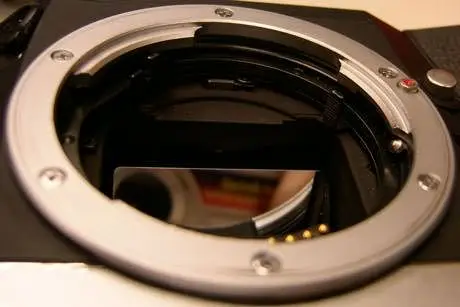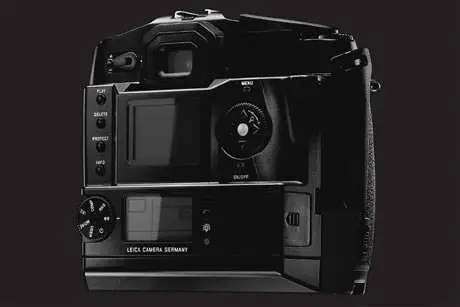Leica R-system cameras
Leica had been slow to develop single lens reflex (SLR) cameras. The first Leicaflex was launched in 1964, that is 28 years after Exakta presented the first SLR for 35mm film, the Kine-Exakta, 12 years after Pentax introduced the Asahiflex, the first SLR camera made in Japan, and five years after Nikon marketed the first SLR system camera, the Nikon F. Moreover, the Leicaflex series and the subsequent R-cameras never quite achieved technological leadership in areas such as metering and exposure control, even though Leica tried to overcome its weakness in photo-electronic components by cooperating with Minolta for the development of the R3 to R7 models. Also, all of the Leica R-system cameras with their R-bayonet mount continued to rely on manual focus, even after autofocus became the industry standard during the 1980s. Nevertheless, Leica's reflex cameras were highly appreciated by amateurs and professionals for their solid build quality, and in particular, for giving photographers access to the broad range of excellent R-system lenses.
In total, Leica sold about 488,000 reflex cameras between 1964 and 2009, with the Leicaflex SL and the Leica R4 being the most popular models. During 2005-07, Leica was also selling a digital back ("Digital-Modul-R") that turned its R8 and R9 into digital cameras. The DMR-sensor offered a 10 MP resolution and had a format factor of 1.37. It added 725 g to the weight of the cameras, as well as 39 mm in height and 27 mm in depth. About 2,200 units of the DMR were produced and sold. A digital Leica R10 with autofocus was developed, but never launched.
The Leica line of reflex cameras shows a steady progression, providing photographers over time with additional functionalities and features. The exceptions to this trend towards higher performance cameras are the R4s and the R-E, which represent less full-featured, lower-priced versions of, respectively, the R4 and the R5. Also, the fully mechanical R6/6.2 is an outlier to the tendency to provide more electronics and automation in newer camera models. More details on the changes between camera models are contained in the listing below:




Leicaflex ("Standard"):
- first single-lens reflex camera from Leica;
- fully mechanical design;
- solid metal construction;
- external CdS exposure meter;
- shutter speeds up to 1/2000s;
- mirror lock-up;
- used cable connection with coldshoe for flash control;
Leicaflex to Leicaflex SL:
- replaced external CdS-cell by selective (center-spot) light metering through the lens;
- replaced small center-spot focusing screen with ground-glass focusing screen;
- replaced mirror-lock up function with depth-of-field preview;
Leicaflex SL to Leicaflex SL2:
- added hotshoe for flash control;
- added aperture read-out in the viewfinder and viewfinder illumination;
Leicaflex SL2 to Leica R3:
- based body on Minolta XE;
- offered automated exposure control in aperture or shutter priority;
- added integrated (center-weighted) light metering option;
- used different shutter with lower (1/1000s) maximum speed;
Leica R3 to R4:
- offered fully automated program exposure mode;
- offered winder support for all models (not only the MOT models);
- used lighter and smaller body (based on the Minolta XD);
Leica R4 to Leica R4s:
- omitted program and shutter priority exposure modes;
- offered the camera at a lower price point;
Leica R4 to Leica R5:
- provided TTL-based flash control;
- included a shutter with a higher (1/2000s) maximum shutter speed;
- improved anti-dust sealing of control elements;
Leica R5 to Leica R-E:
- omitted program and shutter priority exposure modes;
- offered the camera at a lower price point;
Leica R5 to Leica R6:
- reduced electronics to a minimum, so that the camera functions without a battery;
- omitted all automatic (P, A, S) exposure modes;
- employed a mechanical shutter with a lower (1/1000s) maximum shutter speed;
Leica R5 to Leica R7:
- included fully automated TTL flash control;
- added digital viewfinder display of shutter speed with backlighting;
- offered automatic DX film sensitivity setting with manual override;
- extended base of camera body to accommodate additional electronics;
Leica R6 to Leica R6.2:
- included a shutter with a higher (1/2000s) maximum shutter speed;
Leica R7 to Leica R8:
- offered redesigned camera body with superior ergonomics, but additional bulk;
- included a shutter with a higher (1/8000s) maximum shutter speed;
- added multi-pattern (matrix) light metering mode;
- changed viewfinder display to digital LED;
Leica R8 to Leica R9:
- offered High Speed Synchronization flash control;
- added an LCD frame counter on the top plate;
- added lock to mode selector dial;
- added lighting to rear LCD display;
- reduced body weight by 100g through use of different materials (magnesium casting, aluminum) for the top and bottom plate;
In total, Leica released 13 reflex camera models. In addition, there were also motorized versions sold of the Leicaflex SL, Leicaflex SL2, and R3, which varied from the parent model by their ability to attach a winder and the omission of the self-timer. Most Leica reflex cameras were available both in black and in chrome, and some of them also in khaki or gold. The Leica family tree shows a total of 31 varieties of Leica reflex cameras (10 Leicaflex, 21 Leica-R). The listed price information on pre-owned cameras provides an indication of the relative scarcity of the different models, with the Leicaflex SL2, the R6.2, and the R9 fetching relatively high prices in the used camera market.

| Camera | Shutter (1/sec) | TTL- metering | Exposure modes | Hot- shoe | Flash control | Size (mm) | Weight (g) | Prod run | Prod period | Price range ($) | ebay offers | ||
|---|---|---|---|---|---|---|---|---|---|---|---|---|---|
| 1 | Leicaflex | 2000 | - | M | No | non-TTL | 148.0 / 97.0 / 57.0 | 770 | ~32,500 | 1964 - 68 | 200-400 | check | |
| 2 | Leicaflex SL | 2000 | sel | M | No | non-TTL | 148.0 / 97.0 / 57.0 | 770 | ~75,000 | 1968 - 74 | 125-250 | check | |
| 3 | Leicaflex SL2 | 2000 | sel | M | Yes | non-TTL | 148.0 / 97.0 / 57.0 | 770 | ~25,000 | 1974 - 76 | 400-600 | check | |
| 4 | Leica R3 | 1000 | sel & int | A/S/M | Yes | non-TTL | 148.0 / 96.5 / 64.6 | 780 | ~70,000 | 1976 - 80 | 125-250 | check | |
| 5 | Leica R4 | 1000 | sel & int | P/A/S/M | Yes | non-TTL | 138.5 / 88.1 / 60.0 | 630 | >100,000 | 1980 - 87 | 150-250 | check | |
| 6 | Leica R4s | 1000 | sel & int | A/M | Yes | non-TTL | 138.5 / 88.1 / 60.0 | 620 | ~25,000 | 1983 - 87 | 150-250 | check | |
| 7 | Leica R5 | 2000 | sel & int | P/A/S/M | Yes | TTL | 138.5 / 88.1 / 62.2 | 625 | ~34,000 | 1986 - 91 | 250-500 | check | |
| 8 | Leica R6 | 1000 | sel & int | M | Yes | TTL | 138.5 / 88.1 / 62.2 | 625 | ~24,000 | 1988 - 92 | 400-550 | check | |
| 9 | Leica R-E | 2000 | sel & int | A/M | Yes | TTL | 138.5 / 88.1 / 62.2 | 625 | ~6,100 | 1990 - 94 | 450-600 | check | |
| 10 | Leica R6.2 | 2000 | sel & int | M | Yes | TTL | 138.5 / 88.1 / 62.2 | 625 | ~21,000 | 1992 - 02 | 500-750 | check | |
| 11 | Leica R7 | 2000 | sel & int | P/A/S/M | Yes | full-auto | 138.5 / 98.8 / 62.2 | 670 | ~30,000 | 1992 - 97 | 350-450 | check | |
| 12 | Leica R8 | 8000 | sel, int, multi | P/A/S/M | Yes | full-auto | 158.0 / 101 / 62.0 | 890 | ~36,500 | 1996 - 02 | 500-600 | check | |
| 13 | Leica R9 | 8000 | sel, int, multi | P/A/S/M | Yes | HSS | 158.0 / 101 / 62.0 | 790 | ~9,000 | 2002 - 09 | 1,000-1,500 | check |
Further Reading
In case you have misplaced the instructions for your Leicaflex or R-camera, you can get a free softcopy of the Operating Manual on a separate page of this site. Similarly, many of Leica's promotional brochures can be downloaded for free. This includes an updated version of the Leica family tree that shows the evolution of the main Leica camera lines over time.
You are here: Home » Camera Hub » Leica R Cameras